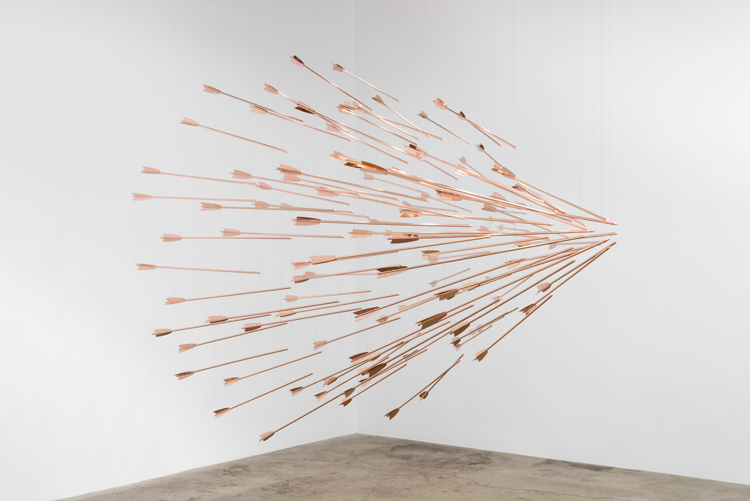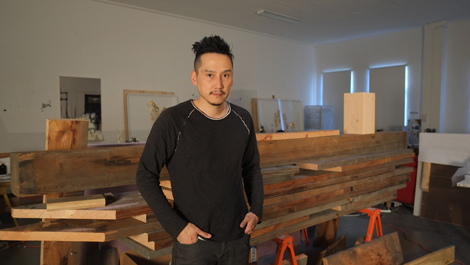After dodging the reporters and cameramen that were shooting footage of Leonard Nimoy’s star for memorial news coverage on Hollywood Boulevard, I was buzzed into Glenn Kaino’s studio and escorted up to the second floor by an assistant. Once face to face with the artist it became immediately apparent that this product of the UC system (UC Irvine, BFA and UCSD, MFA) is not only an intellectual, but also the epitome of LA cool. In his early 40s, with a casual but pulled-together look and hip quiff hairstyle, it looked as if he had just rushed from a GQ magazine photo shoot. We spoke about life, work, technology, collaboration and the monumental year that he had in 2014.
Kaino is a natural multitasker—he sits and flips through the Artillery paraphernalia that I brought as he casually answers my first several rounds of questions. If I reference an artist’s work he is not familiar with, 30 seconds later he is Googling images on his phone, never missing a beat in the conversation. This seeming casual but fully engaged conversational style is one index of his facility; he toggles seamlessly between perceptual, intellectual and creative levels of engagement.
Kaino is one of a new breed of artist/entrepreneurs—an intellectual free spirit bound to no artistic genre—gracefully transitioning from the role of artist to that of corporate executive in the media world, and back again. To understand the multiple personalities of Kaino is to understand that the same creativity applies in each of these roles.
Kaino claims that the people who brought him into these large media projects—whether it was at the Oprah Network, Napster, or a multitude of others—knew that what they were signing up for was by no means traditional. “They were savvy and aware of my role as an artist and very aware that bringing me in was an unconventional decision because both my practice and my methodologies are unconventional,” he tells me.
From fetish fabrication and the use of new technology, to the deconstruction and subsequent DIY reassembly of commonplace life-ephemera into social activist sculpture—there is no construct to predict when Kaino’s wealth of varying interests may next manifest into art. Read any article on him and you will see references to “kit-bashing,” a model-maker’s term for taking all the pieces from a project, spreading them out on a table, then making whatever the hell you want. Sometimes, it would seem instructions and plans simply get in the way of true vision.
With a creative process that commingles discrete worlds and bodies of knowledge, Kaino notes, “the circumstances created with art-making allow for true generative exchange to happen.” This was no more evident than when both the chess world and the contemporary art world converged on the World Chess Hall of Fame in St. Louis, Missouri last year to watch Magnus Carlsen, former child chess prodigy (and fashion model), now established grandmaster ranked No. 1 in the world—face off with acclaimed artist, magician and former corporate media executive, Glenn Kaino. Just to make things a tad more exciting, Kaino’s “Burning Boards” work (originally shown at the Whitney Museum in 2007) substitutes flaming candles for the chess pieces.
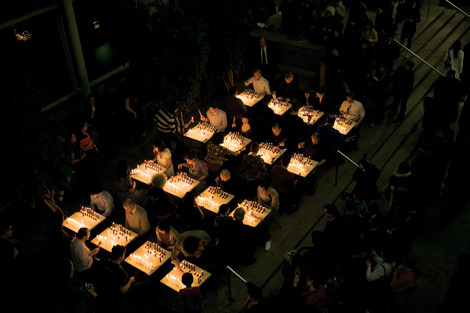
Glenn Kaino, Burning Boards, 2007, thirty-two players, sixteen chess sets of wood and wax, tongs and lighters, dimensions variable, installation view at the Whitney Museum of American Art, Photo Nhat Nguyen, Courtesy Honor Fraser Gallery.
In preparation for the event, Kaino had been practicing against the Magnus Carlsen App, which allows one to play the grandmaster at different ages. With this, Kaino knew that he could beat an 8-year-old Carlsen. Unfortunately, the champ is now in his mid-20s and Kaino needed an alternative strategy. “I created the one circumstance in chess where I knew more about the game than he did. I took the disadvantage and chose black, allowing Carlsen to make the first move. He would move his pieces, and then I just copied him. What he didn’t know was when I was going to stop copying him.” This strategy garnered a smile from Carlsen and allowed Kaino to last a couple dozen moves against one of the greatest chess players in history. Kaino doesn’t take all the credit, giving some to the “generosity of Magnus Carlsen,” who may or may not have thrown him a couple of secret signals during the last handful of those moves.
In addition to his chess performance, Kaino had what many would refer to as an epic 2014: solo exhibitions at the Studio Museum in Harlem, Kavi Gupta Gallery in Chicago, the historic Naval Building 170 in D.C. and inclusion in New Orleans Biennial (Prospect 3). With all of this, it only seems appropriate that he begin 2015 focused in Los Angeles, the city he grew up in, with a solo show at Honor Fraser gallery and the finalizing of the “research phase” for the giant 6th Street Viaduct commission. Kaino was selected to provide the artistic support for the downtown 6th street bridge section of this major redevelopment effort—a part of the hotly debated LA River Revitalization Project. His contribution alone could have a budget of over a million dollars.
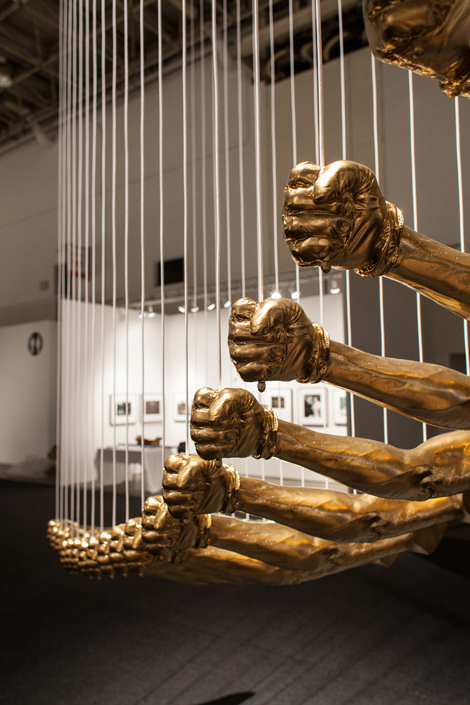
Glenn Kaino, Bridge, 2014, (detail) photo Joseph Rynkiewicz, Courtesy Kavi Gupta Gallery and Glenn Kaino Studio.
While speaking cryptically about 6th Street—none of his design details have officially been released—Kaino jokes that throughout his career he has “built a lot of bridges.” Among the multiple implied references, three major works spring to mind from his catalog. The 6th Street undertaking is the largest and most recent to date, but each of his bridge-centric creations has been heroic in its own right.
The first was commissioned to be a six-month public artwork as a part of Pittsburgh’s 250th anniversary celebration. The celebrated sculpture is something akin to a large transformer robot, each of its components consisting of a different bridge located within the Steel City. Beloved by its residents, Arch (2008) was recently restored and relocated to a permanent new home at the Pittsburgh International Airport.
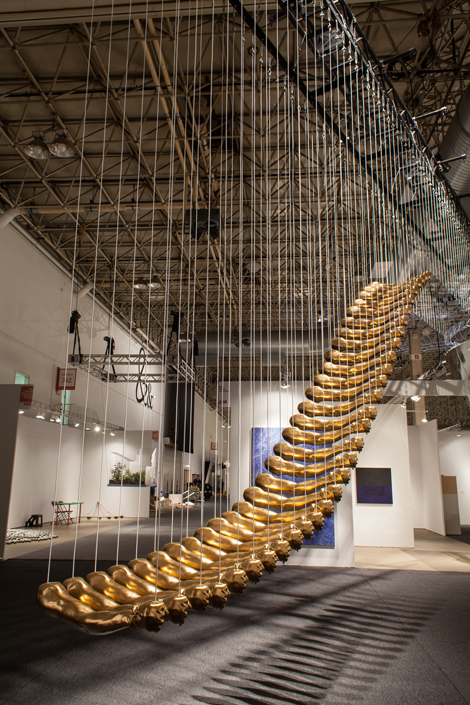
Glenn Kaino, Bridge, 2014, photo Joseph Rynkiewicz, Courtesy Kavi Gupta Gallery and Glenn Kaino Studio.
The last major project, simply titled Bridge, was one of Kaino’s standouts from 2014. The work was shown in several iterations last year, its largest being the site-specific installation at the Naval Building 170 in Washington, D.C. Bridge has heavy conceptual and cultural relevance as it re-imagines and relocates Olympian and activist Tony Smith’s iconic civil rights gesture from the 1968 Olympics back in the contemporary discourse. The 200 painted gold casts of Tony Smith’s arm are suspended gracefully in mid-air, taking the gesture out of its original context but also creating a dramatic vehicle to spur further conversation about social and political disenfranchisement. What Bridge represents is at the core of many of Kaino’s artworks; they function as the catalyzing element in which history, social activism, art and discourse all collide in one special moment.
Kinetic machines, performances, physical and metaphorical bridges, to board games on fire, to sheer magic—there is no anticipating what is coming next from this protean imagination. As the audience, we must simply sit back and wait for the next show, the next performance, the next wild idea. In Kaino’s words, “It is about the poetics of not knowing—about both mining and understanding the membrane between the known and the unknown.”

